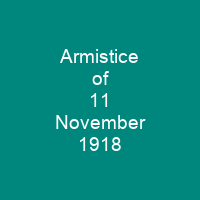The Armistice of 11 November 1918 was the armistice signed at Le Francport near Compiègne. It ended fighting on land, sea and air in World War I between the Allies and their last remaining opponent, Germany. Previous armistices had been agreed with Bulgaria, the Ottoman Empire and the Austro-Hungarian Empire. The Treaty of Versailles, which was signed on 28 June 1919, took effect on 10 January 1920.
About Armistice of 11 November 1918 in brief

It came into force at 11: 00 a. m. Paris time on November 11, 1918, but fighting continued up to 11 o’clock, with 2,738 men dying on the last day of the War. The German Supreme Army Command at Imperial Army Headquarters in Spa of occupied Belgium informed Kaiser Wilhelm II and the Imperial Chancellor, Count Georg von Hertling, that the military situation facing Germany was hopeless. In late October 1918, Ludendorff, in a sudden change of mind, declared the conditions of the Allies unacceptable. He now demanded to resume the war which he himself had declared lost only one month earlier. However, the German soldiers were pressing to get home. It was scarcely possible to arouse their readiness for battle anew, and desertions were on the increase. The Imperial Government stayed on course and Ludwig Groener was replaced by Wilhelm Groener. He put the responsibility for the capitulation and its consequences squarely into the hands of the democratic parties and the parliament. He expressed his view to officers of his staff on 1 October: \”They now must lie on the bed that they’ve made for us.\” On 3 October 1918,. the liberal Prince Maximilian of Baden was appointed Chancellor of Germany, replacing Georg Von Hertling in order to negotiate an armistsice. On 5 November, the Allies agreed to take up negotiations for a truce, now also demanding reparation, now from Germany.
You want to know more about Armistice of 11 November 1918?
This page is based on the article Armistice of 11 November 1918 published in Wikipedia (as of Nov. 29, 2020) and was automatically summarized using artificial intelligence.







